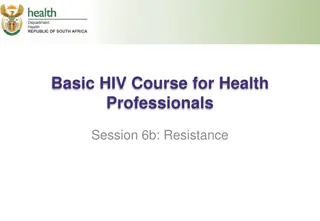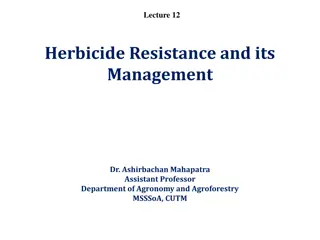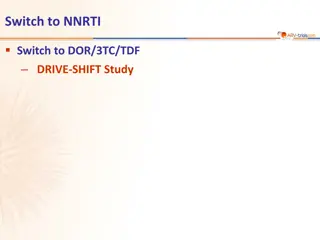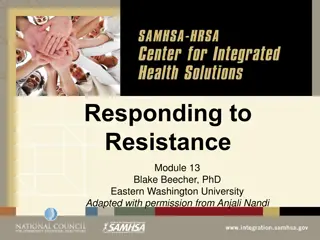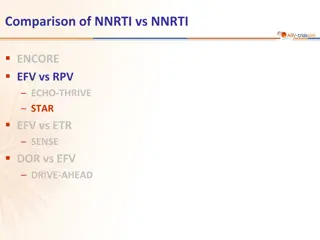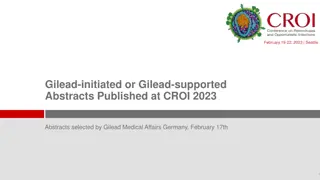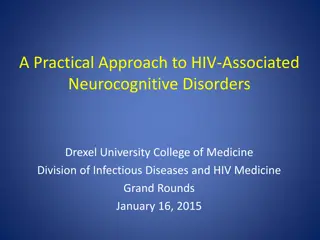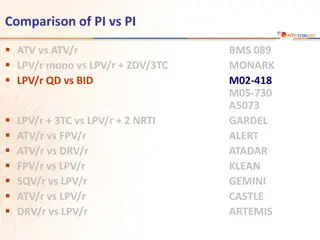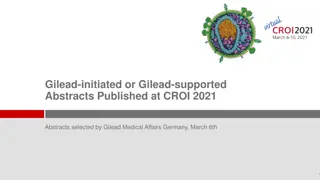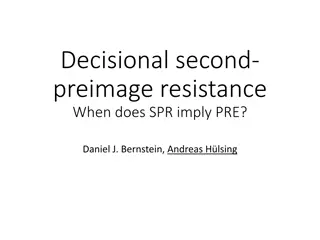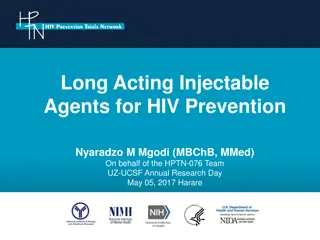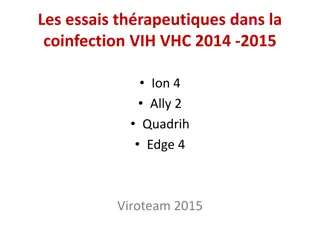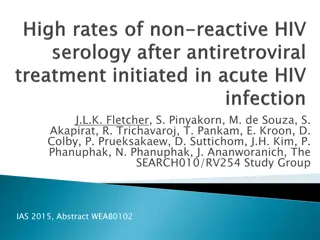Resistance Analysis of Long-Acting Lenacapavir in HIV Treatment: 104-Week Findings
Study on long-acting lenacapavir in heavily treatment-experienced HIV individuals after 104 weeks revealed emergence of lenacapavir resistance-associated mutations. Lenacapavir, a potent HIV-1 capsid inhibitor, has shown activity against ARV-resistant strains. The CAPELLA study analyzed lenacapavir resistance mutations up to Week 104, shedding light on its efficacy and challenges in treating HIV. This research contributes valuable insights for future HIV treatment strategies.
Download Presentation

Please find below an Image/Link to download the presentation.
The content on the website is provided AS IS for your information and personal use only. It may not be sold, licensed, or shared on other websites without obtaining consent from the author. Download presentation by click this link. If you encounter any issues during the download, it is possible that the publisher has removed the file from their server.
E N D
Presentation Transcript
Resistance Analysis of Long-Acting Lenacapavir in Heavily Treatment-Experienced People with HIV after 104 Weeks of Treatment Nicolas Margot, Vamshi Jogiraju, Laurie VanderVeen, Vidula Naik, Hadas Dvory-Sobol, Martin S. Rhee, and Christian Callebaut Please scan for plain language summary: Gilead Sciences, Inc. Foster City, California, USA The 19th European AIDS Conference. 18 21 October 2023. Warsaw, Poland. Oral: PS8 O4
Disclosures N Margot, V Jogiraju, L VanderVeen, V Naik, H Dvory-Sobol, MS Rhee, and C Callebaut are all employees and shareholders of Gilead Sciences, Inc. 2
Lenacapavir (LEN) LEN is a potent (EC50 50 100 pM) first-in-class, long-acting HIV-1 capsid inhibitor1 LEN is active against HIV-1 with resistance against existing ARVs2,3 LEN has been approved for the treatment of HTE PWH in combination with an OBR4,5 Emergence of LEN RAMs at Week 52 (n=9) in the CAPELLA study were previously reported3 CA residue L56 M66 Q67 K70 N74 A105 T107 In vivo I H/K/N H/N/R/S D/H T/S A/C/N/S In vitro I I H N D/S N Objective: To analyze the emergence of LEN RAMs through Week 104 of the CAPELLA study 1. Link JO, et al. Nature 2020;584:614 8. 2. Margot N, et al. Antimicr Agents Chemother 2021;65:e02057 20. 3. Margot N, et al. Presented at CROI 2022; Poster 508. 4. Segal-Maurer S, et al. N Engl J Med 2022;386:1793 803. 5. Ogbuagu O, et al. Lancet HIV 2023;1:e497 e505. ARV, antiretroviral; CA, capsid; EC50 half maximal effective concentration; HTE, heavily treatment experienced; LEN, lenacapavir; OBR, optimized background regimen; PWH, people with HIV-1; RAM, resistance-associated mutation. 3
CAPELLA Study Design1 Functional monotherapy Key eligibility criteria Maintenance HIV-1 RNA 400 c/mL Resistance to 2 agents from 3/4 main ARV classes 2 fully active agents from 4 main ARV classes Baseline Day 14 Oral LEN SC LEN Q6M for 104 weeks n=24 Failing regimen OBR Randomized cohort Double blind NO Placebo Oral LEN SC LEN Q6M for 104 weeks Screening period Pre-randomization repeat HIV-1 RNA Decline 0.5 log c/mL (vs screening); or <400 c/mL n=12 Failing regimen OBR Oral LEN SC LEN Q6M for 104 weeks YES n=36* Non-randomized cohort Open label OBR OBR 82% of participants were suppressed at Week 104 (M=E)2 Mean increase in CD4 cell count of 122 cells/ L from baseline to Week 1042 *Enrolled after not meeting criteria for randomized cohort, n=3; enrolled after randomized cohort enrollment was completed, n=33 (of those, n=28 met the randomization criteria). Primary endpoint: HIV-1 RNA decrease 0.5 log10 c/mL in randomized cohort. Oral LEN 600 mg on Days 1 and 2, and 300 mg on Day 8; SC LEN administered as 927 mg (2 x 1.5 mL) in abdomen on Day 15 then Q6M. 1. Segal-Maurer S, et al. N Engl J Med 2022;386:1793 803. 2. Ogbuago O, et al. Presented at IDWeek 2023; Poster 1596. ARV, antiretroviral; c/mL, copies/mL; LEN, lenacapavir; M=E, missing=excluded; OBR, optimized background regimen; Q6M, every 6 months; SC, subcutaneous. 4
Resistance Analysis Population and Emerging LEN RAMs at Week 104 Genotypic/phenotypic analyses (capsid, protease, RT, integrase) performed at virologic failure* Category, n (%) CAPELLA (N=72) Resistance analysis population LEN RAM emergence M66I Q67H/K/N K70H/N/R/S N74D/H/K A105T/S T107A/C/N/S No LEN RAM emergence 27 (38) 14 (19) 6 (8) 8 (11) 7 (10) 3 (4) 4 (6) 3 (4) 13 (18) Plasma OBR drug concentrations quantification (LC-MS/MS methods) DRV, DTG, TAF/TFV, FTC *Virologic failure defined as confirmed rebound 50 copies/mL or <1 log10 decline from baseline at Week 4. Resistance assays conducted at Monogram Biosciences. DRV, darunavir; DTG, dolutegravir; FTC, emtricitabine; LC-MS/MS, liquid chromatography-tandem mass spectrometry; LEN, lenacapavir; OBR, optimized background regimen; RAM, resistance-associated mutation; RT, reverse transcriptase; TAF, tenofovir alafenamide; TFV, tenofovir. 5
Summary of Participants with LEN RAMs Through Week 104 (n=14) VF participants with LEN RAMs (n=14) Non-adherence to OBR (had at least 1 fully active agent) Outcome After VF Suboptimal OBR (had no fully active agents) Resuppressed 1. 2. 3. 4. 5. 11. 12. Q67H M66I Q67H N74D A105T N74K K70N M66I T107A M66I K70S N74D Q67H Did not resuppress 13. 14. 6. 7. M66I N74D A105T M66I A105T Q67H K70R A105T M66I Q67H K70R T107C 8. 9. 10. K70H Q67K K70R T107N Q67H K70R Q67H 6 LEN, lenacapavir; OBR, optimized background regimen; RAM, resistance-associated mutation; VF, virologic failure.
Summary of Participants with LEN RAMs Through Week 104 (n=14) VF participants with LEN RAMs (n=14) Non-adherence to OBR (had at least 1 fully active agent) Outcome After VF Suboptimal OBR (had no fully active agents) Resuppressed 1. 2. 3. 4. 5. 11. 12. Q67H M66I Q67H N74D A105T N74K K70N M66I T107A M66I K70S With OBR Change N74D Q67H Did not resuppress 13. 14. 6. 7. M66I N74D A105T M66I A105T Q67H K70R A105T M66I Q67H K70R T107C 8. 9. 10. K70H Q67K K70R T107N Q67H K70R Q67H Post VF, 7 of 14 participants with LEN RAMs achieved HIV-1 RNA <50 c/mL on LEN + OBR 7 LEN, lenacapavir; OBR, optimized background regimen; RAM, resistance-associated mutation; VF, virologic failure.
LEN Phenotypic Data I Participants with LEN RAMs LEN FC were not correlated with outcome Participants with LEN RAMs # Visit Genotype LEN FC* Outcome after VF Q67H 1. 4.5 Resuppressed W88 LEN FC were not correlated with number of RAMs Q67H 5. 6.6 Resuppressed W52 T107C M66I Q67H K70R 14. 12.2 Not resuppressed W4 Q67H K70R 10. 14.8 Not resuppressed W4 Q67H K70R A105T 7. 105.0 Not resuppressed W88 13. 111.0 Not resuppressed W52 M66I A105T M66I T107A 12. 234.0 Resuppressed W10 2. 289.0 Resuppressed K70N W78 N74K 8. 342.0 Not resuppressed W88 Q67K K70H 9. 393.0 Not resuppressed K70R T107N W78 Q67H M66I N74D A105T 6. >869.0 Not resuppressed W52 11. M66I Q67H N74D A105T >869.0 Resuppressed W10 3. NA Resuppressed W4 M66I K70S N74D 4. NA Resuppressed W72 *Monogram Gag-Pro PhenoSense single-cycle assay; LEN fold change compared with wild type. FC, fold change; LEN, lenacapavir; NA, not available; RAM, resistance-associated mutation; VF, virologic failure; W, week. 8
LEN Phenotypic data I Patient Clones and Site-Directed Mutants Patient Clones and Site-Directed Mutants Additional characterization: # Genotype RC (%)a LEN FCa LEN FC MT-2b A. M66I 0.6 >869.0 Non-infectious Reasonable correlation between assays B. A105T M66I 1.2 >869.0 Non-infectious M66I C. 1.5 >869.0 Non-infectious Lack of replication in multicycle assays K70R D. Q67H M66I 3.1 >869.0 Non-infectious E. 12.0 >869.0 Non-infectious M66I High LEN FC associated with low RC F. 24.0 >869.0 Non-infectious M66I T107S M66I K70S G. AF AF Non-infectious H. AF Non-infectious AF A105T K70R I. 9.7 Non-infectious 1.2 J. 9.8 Non-infectious 154.2 K70H K70H K. 37 84.8 345 L. K70S AF Non-infectious AF M. 49.0 42.4 17.0 N74D N. Q67H 58.0 4.8 7.7 O. 109.0 46.3 45.3 Q67H K70R T107S aMonogram Gag-Pro PhenoSense single-cycle assay; FC, fold-change compared to wild-type (WT); bMT-2, 5-day multicycle in-house assay. AF, assay failure; FC, fold-change; NA, not available; RC, replication capacity; SDM, site-directed mutants; 9
Conclusions Capella participants were HTE with limited treatment options Virologic suppression with LEN + OBR was maintained in 82% of participants (M=E) at Week 104 LEN RAMs occurred in 14 out of 72 participants LEN RAMs were associated with either inadequate OBR adherence or an OBR lacking fully-active ARVs Most LEN RAMs were associated with strong reduction in replication capacity Some participants with LEN RAMs resuppressed upon resumption of OBR or with an OBR change 10 ARV, antiretroviral; HTE, heavily treatment experienced; LEN, lenacapavir; M=E, missing=excluded; OBR, optimized background regimen; RAM, resistance-associated mutation.
Acknowledgments Please scan for plain language summary: We extend our thanks to: The study participants and their families Participating study investigators and staff: Canada: J Brunetta, B Trottier; Dominican Republic: E Koenig; France: J-M Molina, S Ronot-Bregigeon, Y Yazdanpanah; Germany: H-J Stellbrink; Italy: A Antinori, A Castagna, F Castelli; Japan: T Shirasaka, Y Yokomaku; South Africa: M Rassool; Spain: J Mallolas; Taiwan: C-C Hung; Thailand: A Avihingsanon, P Chetchotisakd, K Siripassorn, W Ratanasuwan; United States: DS Berger, M Berhe, C Brinson, CM Creticos, GE Crofoot, E DeJesus, D Hagins, T Hodge, K Lichtenstein, JP McGowan, O Ogbuagu, O Osiyemi, GJ Richmond, MN Ramgopal, PJ Ruane, W Sanchez, S Segal-Maurer, J Sims, GI Sinclair, DA Wheeler, A Wiznia, K Workowski, C Zurawski This study was funded by Gilead Sciences, Inc. Medical writing support was by Jessica Woods of Ashfield MedComms (Macclesfield, UK), an Inizio company, and funded by Gilead Sciences, Inc. 11



